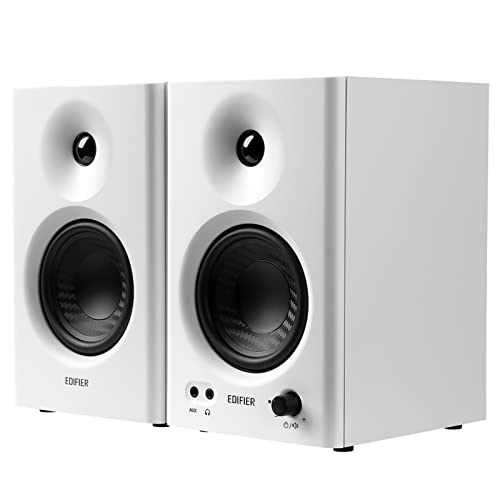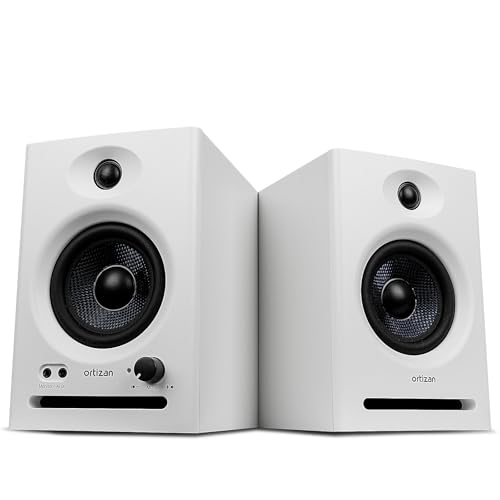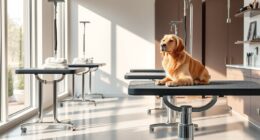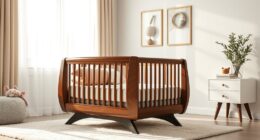If you’re after the best studio monitor speakers for crisp, accurate sound in 2025, I highly recommend checking out models like the Yamaha HS5 and KRK RP5G5 for their flat response and balanced tone. Others like the PreSonus Eris series or ADAM Audio D3V also deliver precise sound for mixing and editing. Each offers unique features like Bluetooth connectivity and durability. Stick with me to explore these options in detail so you find the perfect match.
Key Takeaways
- The list features monitors with flat frequency responses for honest, detailed sound ideal for mixing and editing.
- It includes models with high-quality drivers like silk dome tweeters and Kevlar woofers for accurate audio reproduction.
- Monitors offer versatile connectivity options such as TRS, RCA, USB-C, and Bluetooth for flexible setup.
- Compact designs suited for desktop or small studio spaces, with features enhancing stereo imaging and sound clarity.
- Top picks combine durability, stylish finishes, and advanced controls to meet professional and home studio needs.
PreSonus Eris 3.5 Studio Monitors (Pair)
If you’re looking for a compact, high-quality studio monitor that delivers professional sound without taking up much space, the PreSonus Eris 3.5 is an excellent choice. These monitors provide studio-quality, accurate sound perfect for music production, multimedia, or hi-fi listening. They feature woven-composite woofers for tight bass and cleaner sound, along with 1-inch silk-dome tweeters for natural high frequencies. With 50 watts of Class AB amplification, they offer powerful volume with clarity. The design includes high- and low-frequency controls for tailored sound, making them versatile for various environments, whether on a desk or near a turntable.
Best For: musicians, producers, or audiophiles seeking compact, high-quality studio monitors for accurate sound in small spaces.
Pros:
- Delivers studio-quality, precise sound suitable for music production and multimedia.
- Compact design with versatile connectivity options including TRS, RCA, and aux inputs.
- Customizable sound with high- and low-frequency tuning controls for tailored listening experiences.
Cons:
- Limited to 50W total power, which may be insufficient for very large or loud environments.
- Lacks built-in Bluetooth or wireless streaming capabilities.
- May require additional acoustic treatment or positioning adjustments for optimal performance in some rooms.
YAMAHA Hs5 Powered Studio Monitor, Pair
The Yamaha HS5 Powered Studio Monitor Pair is an excellent choice for musicians, producers, and engineers who need accurate and reliable sound reproduction in their studio. These monitors feature a 2-way bass reflex design with a 5-inch cone woofer and a 1-inch dome tweeter, delivering a frequency response from 54 Hz to 30 kHz. With 70W total power—45W for lows and 25W for highs—they provide clear, detailed sound without coloration. The inclusion of XLR and TRS inputs guarantees versatile connectivity for balanced or unbalanced signals. Perfect for near-field monitoring, these monitors help me hear every nuance with sonic purity.
Best For: musicians, producers, and sound engineers seeking accurate and reliable near-field studio monitoring for professional or home studio environments.
Pros:
- Delivers precise, uncolored sound across a wide frequency range from 54 Hz to 30 kHz
- Features versatile XLR and TRS inputs for balanced and unbalanced connections
- Compact, high-quality design ideal for near-field monitoring in various studio setups
Cons:
- May be less powerful for large or highly treated rooms due to 70W total output
- No built-in Bluetooth or wireless connectivity options
- Slightly higher cost compared to entry-level monitors with similar features
Yamaha HS3 Powered Studio Monitor in Black, Pair (HS3 B)
For those seeking accurate and reliable stereo monitoring in a compact form, the Yamaha HS3 Powered Studio Monitor in Black, Pair (HS3 B) delivers exceptional clarity with its precise 3.5-inch woofer and high-frequency response. Its 2-way bass-reflex design guarantees balanced sound, covering a frequency range of 70 Hz to 22 kHz. With 26 W of power per speaker, it provides ample volume for most studio setups. The included room control and high trim response adjustments let you tailor the sound to your environment. Connectivity options feature XLR/TRS, RCA, and stereo mini inputs, making it versatile for various setups. Overall, a dependable choice for professional and home studios.
Best For: Home and professional studio users seeking accurate, reliable stereo monitoring with a compact design.
Pros:
- Clear and precise sound with a balanced frequency response from 70 Hz to 22 kHz
- Versatile connectivity options including XLR/TRS, RCA, and stereo mini inputs
- Adjustable room control and high trim response for tailored sound calibration
Cons:
- Limited low-frequency response due to the 3.5-inch woofer, not ideal for deep bass needs
- Power output of 26 W per speaker may be insufficient for very large or loud environments
- Compact size may not suit users requiring larger monitors for detailed audio production
PreSonus Eris 4.5BT Bluetooth Studio Monitors
PreSonus Eris 4.5BT Bluetooth Studio Monitors stand out as an ideal choice for multimedia enthusiasts and home studio creators who need versatile, high-quality speakers that combine wired and wireless connectivity. These 4.5-inch powered monitors deliver 25 watts per speaker, offering clear, balanced sound with deep bass and natural high frequencies. They feature multiple connection options, including balanced TRS, RCA, and a front-panel aux input, plus Bluetooth 5.0 for wireless streaming. With tunable High and Low controls, you can customize the sound to suit your space and preferences. Compact yet powerful, they’re perfect for desktop setups and near-field listening environments.
Best For: multimedia enthusiasts, home studio creators, and anyone seeking versatile, high-quality speakers with both wired and wireless connectivity options.
Pros:
- Offers multiple connectivity options including Bluetooth 5.0, TRS, and RCA for flexible setup
- Compact design suitable for desktop and near-field listening environments
- Tunable High and Low controls allow precise sound customization to match room acoustics and personal preferences
Cons:
- Limited to 4.5-inch drivers, which may not provide the deepest bass compared to larger monitors
- 25 watts per speaker may be insufficient for very large or loud listening spaces
- Lack of additional features such as built-in equalizers or advanced room correction tools
Yamaha HS4 Powered Studio Monitor in Black, Pair (HS4 B)
If you’re looking for reliable studio monitors that deliver accurate sound reproduction, the Yamaha HS4 Powered Studio Monitor in black is an excellent choice, especially for small to medium-sized setups. These 2-way bass-reflex speakers feature a 4.5-inch cone woofer and a 1-inch dome tweeter, providing a frequency response from 60 Hz to 22 kHz. With 26 W of output power, they deliver clear, detailed sound. The monitors include room control and high trim response adjustments, plus versatile inputs like XLR/TRS, RCA, and stereo mini. Compact and stable with anti-slip pads, they’re perfect for precise monitoring in limited spaces.
Best For: small to medium-sized studio setups requiring accurate and reliable sound monitoring.
Pros:
- High-quality sound reproduction with clear and detailed audio.
- Versatile input options including XLR/TRS, RCA, and stereo mini.
- Compact design with anti-slip pads for stability and space efficiency.
Cons:
- Limited to 60 Hz – 22 kHz frequency response, which may not suit deep bass-heavy production.
- 26 W output power might be insufficient for large or loud environments.
- May require additional acoustic treatment for optimal performance in certain spaces.
Edifier MR4 Powered Studio Monitor Speakers (Pair)
The Edifier MR4 Powered Studio Monitor Speakers are an excellent choice for musicians, content creators, and home studio enthusiasts seeking high-quality sound in a compact package. These bookshelf-style monitors feature a sleek, modern design with MDF wood construction that minimizes resonance for clearer audio. Equipped with 1-inch silk dome tweeters and 4-inch composite woofers, they deliver studio-quality sound with a near-flat response, producing detailed highs, smooth mids, and balanced bass. They offer versatile connectivity options, including TRS, RCA, and AUX inputs, along with front headphone output. Easy-to-use touch controls and adjustable modes make them practical, making the MR4 a compelling, affordable option for accurate, immersive listening.
Best For: musicians, content creators, and home studio enthusiasts seeking high-quality, compact studio monitors with versatile connectivity and accurate sound reproduction.
Pros:
- Delivers studio-quality, near-flat response with clear highs and balanced bass
- Compact, stylish MDF wood construction minimizes resonance for better sound clarity
- Easy-to-use touch controls and multiple input options (TRS, RCA, AUX) for versatile setup
Cons:
- Lacks waterproofing and wireless features, limiting use to indoor environments
- Some users report minor issues with LED indicators malfunctioning over time
- Bass is present but not wall-shaking; may require a subwoofer for more substantial low-end performance
YAMAHA HS5 W 5-Inch Powered Studio Monitor (White, 2-Pack) Bundle (2 Items)
Are you looking for studio monitors that deliver honest, crystal-clear sound for professional mixing or home recording? The Yamaha HS5 W 5-Inch Powered Studio Monitors are an excellent choice. These bi-amplified, 2-way nearfield monitors feature an 8-inch cone woofer and a dome tweeter, offering a flat frequency response with detailed mids and solid lows. They’re praised for their accurate, non-coloring sound, making them ideal for mixing, editing, or guitar recording. Arriving well-packaged and in stylish white, they’re durable, reliable, and compatible with laptops, desktops, and TVs. With a high customer rating and great value, this bundle is perfect for serious audio work.
Best For: musicians, home studio owners, and audio professionals seeking accurate, high-quality studio monitors for mixing, editing, and recording.
Pros:
- Crystal-clear, honest sound with flat frequency response for precise mixing
- Solid build quality and stylish white design that enhances studio aesthetics
- Easy compatibility with laptops, desktops, and televisions, making setup straightforward
Cons:
- Slight spike at 1.5 kHz may require adjustment for perfect midrange balance
- Heavier weight (around 33 pounds each) may be less convenient for portable setups
- Limited to indoor use, not suitable for outdoor environments or waterproof needs
Ortizan C7 Dual-Mode 2.0 Studio Monitors (Pair, White)
For audio enthusiasts and professionals seeking versatile connectivity, the Ortizan C7 Dual-Mode 2.0 Studio Monitors stand out with their multiple input options and wireless capabilities. They offer RCA, 6.35mm TRS balanced, AUX, and USB inputs, plus Bluetooth 5.3 for quick pairing with smartphones and tablets. The front headphone jack makes monitoring easy, and the built-in 24-bit DAC guarantees high-fidelity digital sound. With a 3.5-inch carbon fiber mid-bass driver and silk dome tweeter, these monitors deliver precise, balanced audio suitable for music, movies, or production. Their sleek white design fits well in both professional and casual setups, making them a versatile choice.
Best For: audio enthusiasts and professionals seeking versatile, high-fidelity studio monitors suitable for both casual and professional environments.
Pros:
- Multiple input options including RCA, 6.35mm TRS, AUX, and USB for flexible connectivity
- Wireless Bluetooth 5.3 for quick pairing and convenient wireless music streaming
- Built-in 24-bit DAC ensures high-quality digital audio with clear, accurate sound
Cons:
- May be larger than traditional compact bookshelf speakers, requiring more space
- The price point might be higher compared to basic speakers with fewer features
- Designed primarily for studio and professional use, which might be overkill for casual listeners
KRK RP5G5 ROKIT 5 Generation Five 5 Powered Studio Monitor Pair
If you’re looking for reliable studio monitors that deliver precise sound reproduction, the KRK RP5G5 ROKIT 5 Generation Five powered speakers are an excellent choice. Their low diffraction baffle design reduces distortion and enhances stereo imaging, giving you clearer, more accurate sound. The acoustic foam wedge isolation pads minimize resonance and make setup easier. Equipped with custom-designed Class D amplifiers, these monitors maintain audio integrity while running cooler. The new 1” silk dome tweeter improves high-frequency response and phase performance. With versatile XLR and 1/4” TRS inputs, they easily connect to a range of audio gear, making them ideal for professional studio environments.
Best For: audio engineers, music producers, and content creators seeking accurate and reliable studio monitors for professional sound mixing and mastering.
Pros:
- Low diffraction baffle design reduces distortion and improves stereo imaging
- Custom-designed Class D amplifiers ensure clear sound with lower heat output
- New 1” silk dome tweeter enhances high-frequency response and phase performance
Cons:
- May be higher in price compared to entry-level monitors
- Requires proper acoustic treatment for optimal performance
- Limited to nearfield monitoring, less suitable for large studio spaces
Mackie CR3.5 Studio Monitors with Tone Knob and Location Switch
The Mackie CR3.5 studio monitors stand out as an excellent choice for content creators, home studio enthusiasts, and casual listeners who need versatile speakers that deliver professional sound without breaking the bank. These active monitors feature a silk dome tweeter and 3.5-inch woven woofer, providing clear highs and solid low-end response. The built-in tone knob allows for easy sound shaping, while the location switch optimizes placement—desktop or bookshelf—for best audio performance. Connectivity options include TRS, RCA, 3.5mm inputs, and a headphone jack, making setup straightforward across various devices. Compact and durable, they offer excellent value for professional-quality sound in a versatile, user-friendly package.
Best For: content creators, home studio owners, and casual listeners seeking versatile, professional-quality monitors at an affordable price.
Pros:
- Clear, balanced sound with professional-grade clarity and impressive bass response
- Versatile connectivity including TRS, RCA, 3.5mm inputs, and headphone jack for easy setup with various devices
- Compact, durable design with adjustable placement options and user-friendly controls
Cons:
- May require a subwoofer for deeper bass enhancement in certain applications
- Limited size may restrict very high-volume playback or larger room coverage
- Some users might find the tone adjustment options less precise compared to high-end studio monitors
Edifier R1280T Powered Bookshelf Speakers
Edifier R1280T Powered Bookshelf Speakers stand out as an excellent choice for those seeking versatile and high-quality near-field studio monitors. These 2.0 active speakers feature a wooden enclosure that not only looks stylish but also enhances sound clarity. With 42 Watts RMS power, they deliver crisp, detailed audio suitable for mixing or casual listening. Dual AUX inputs make it easy to connect multiple devices simultaneously, and the remote control adds convenience. Side panel knobs allow precise adjustments of volume, bass, and treble. Their classic MDF finish with wood effect vinyl ensures they blend seamlessly into any home or studio environment. Overall, they combine performance, style, and user-friendly features.
Best For: audiophiles, home studio enthusiasts, and casual listeners seeking versatile, stylish bookshelf speakers with customizable sound options.
Pros:
- High-quality wooden enclosure enhances sound clarity and aesthetic appeal
- Dual AUX inputs allow seamless connection of multiple devices simultaneously
- Side panel controls for precise volume, bass, and treble adjustments
Cons:
- Limited to 42 Watts RMS power, which may not be sufficient for large room setups
- No built-in Bluetooth or wireless connectivity options
- Requires space on a sturdy surface for optimal placement and sound quality
PreSonus Eris 3.5 Studio Monitors (White)
For those seeking compact yet high-quality studio monitors, the PreSonus Eris 3.5 Studio Monitors in white stand out with their precise sound and stylish design. They deliver studio-quality, accurate audio perfect for music production, multimedia, or hi-fi listening. The woven-composite woofers produce tight bass and a big low end, while the 1-inch silk-dome tweeters provide natural high frequencies for superior stereo imaging. Powered by 50 watts of Class AB amplification, they fill rooms with clear, balanced sound. With multiple input options—TRS, RCA, and auxiliary—and adjustable high- and low-frequency controls, these monitors are versatile and easy to customize for any setup.
Best For: musicians, producers, and audiophiles seeking compact, studio-quality monitors for accurate sound reproduction in small to medium setups.
Pros:
- Studio-quality, precise audio with tight bass and natural high frequencies
- Versatile connectivity options including TRS, RCA, and auxiliary inputs
- Adjustable high- and low-frequency controls for tailored sound performance
Cons:
- Limited power output for large room coverage
- Compact size may not suit those needing deep bass for certain music styles
- Slightly higher price point compared to basic multimedia speakers
SW208 3 Active Bluetooth 5.0 Bookshelf Speakers
If you’re looking for versatile bookshelf speakers that combine stylish design with high-quality sound, the SW208 3 Active Bluetooth 5.0 Bookshelf Speakers are an excellent choice. Their elegant wood finish and compact size make them suitable for any space. Equipped with 30W x 2 carbon fiber speaker units, they deliver warm midrange, deep bass, and bright treble. Bluetooth 5.0 ensures stable wireless connectivity, while a built-in 24-bit DAC provides high-fidelity digital audio. Plus, with adjustable treble, bass, and volume controls, you can tailor the sound to your preference. These speakers also feature energy-saving standby modes, making them both powerful and efficient.
Best For: audiophiles and music enthusiasts seeking stylish, versatile bookshelf speakers with high-fidelity sound and customizable audio control.
Pros:
- Elegant wood finish and compact design suitable for various spaces
- Powerful 30W x 2 carbon fiber speaker units deliver rich, balanced sound
- Bluetooth 5.0 for stable wireless connectivity and built-in 24-bit DAC for high-quality digital audio
Cons:
- May require additional equipment for optimal placement and setup
- Lacks built-in microphone or voice assistant features
- Limited to Bluetooth and USB connections, without Wi-Fi or additional input options
ADAM Audio D3V Active Desktop Monitors (Pair, Black)
The ADAM Audio D3V Active Desktop Monitors are an excellent choice for musicians, producers, and audio enthusiasts seeking professional-grade sound directly from their desks. These fully active monitors deliver ADAM Audio’s renowned clarity with a 1.5” D-ART ribbon tweeter and 3.5” aluminum woofers powered by 80 W amplifiers. Dual passive radiators extend low-frequency response down to 45 Hz, ensuring punchy bass. Connectivity is straightforward with balanced 1/4” inputs and USB-C for computers and mobile devices. The sleek design includes adjustable stands, headphone jack, and DSP controls to optimize placement, making them versatile and ideal for both professional studios and desktop setups.
Best For: musicians, producers, and audio enthusiasts seeking professional-quality desktop monitoring with versatile connectivity and precise sound reproduction.
Pros:
- High-quality sound with clear high frequencies and punchy bass thanks to D-ART ribbon tweeter and passive radiators
- Easy connectivity options including USB-C and balanced 1/4” inputs for flexible setup
- Adjustable stands and mounting options enhance placement and acoustical performance
Cons:
- Compact size may limit low-frequency extension compared to larger monitors
- Requires desk space for stands and proper positioning for optimal sound
- May be more expensive than basic desktop monitors lacking advanced features
M-AUDIO BX3 Studio Monitors (Pair, 3.5″, 120W)
M-AUDIO BX3 studio monitors are an excellent choice for content creators, gamers, and home studio enthusiasts who need compact and versatile speakers. They deliver studio-quality sound with 120 Watts of power, producing deep lows, clear highs, and precise stereo imaging. The 3.5-inch Kevlar drivers and silk dome tweeters ensure balanced, detailed audio suitable for multimedia, streaming, gaming, and casual music production. With multiple connectivity options—including RCA, 1/4”, and auxiliary inputs—they integrate easily with various devices. The stylish MDF cabinet and rear bass reflex port enhance sound quality, making these monitors a practical and affordable upgrade over standard computer speakers.
Best For: content creators, gamers, and home studio enthusiasts seeking compact, versatile monitors with studio-quality sound at an affordable price.
Pros:
- Compact and stylish design ideal for small spaces and easy setup
- Versatile connectivity options including RCA, 1/4”, and auxiliary inputs
- Deliver deep lows and clear highs with balanced sound quality
Cons:
- Lack of high/low frequency controls on the front panel
- Thin jumper cable may occasionally lose connection
- Not suitable for professional studio recording or outdoor use
Factors to Consider When Choosing Studio Monitor Speakers
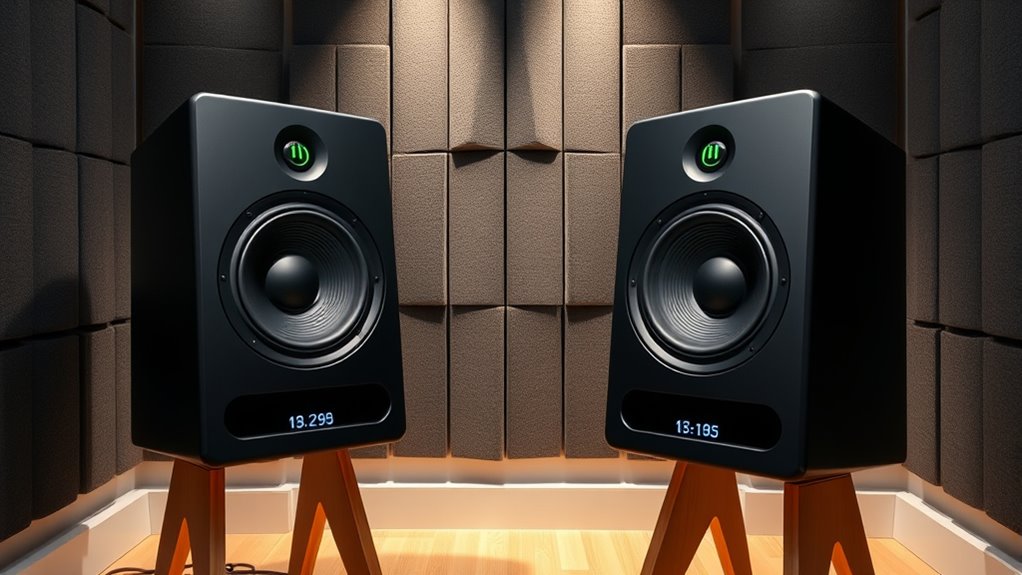
When choosing studio monitor speakers, I focus on sound accuracy and clarity to make certain my mixes are true to life. I also consider connectivity options, size, and power to match my setup and space. Understanding the frequency response range helps me pick monitors that handle the full spectrum of sounds I need to produce.
Sound Accuracy and Clarity
Choosing studio monitor speakers requires careful attention to sound accuracy and clarity, as these qualities directly impact your ability to produce professional mixes. Accurate monitors faithfully reproduce audio without coloration or distortion, ensuring you hear your recordings as intended. Clarity depends on high-quality transducers like silk-dome tweeters and well-designed woofers, which deliver detailed high and low frequencies. A flat frequency response is essential, preventing any range from being overly emphasized or diminished, so your mix remains balanced. High-resolution drivers and precise crossover networks further enhance clarity by revealing subtle audio details. Additionally, proper calibration and tuning controls allow you to optimize sound clarity based on your room acoustics and speaker placement, ensuring consistent, transparent monitoring that supports accurate mixing.
Connectivity Versatility
Connectivity versatility is vital because it determines how seamlessly your studio monitor speakers integrate with various audio sources. I look for monitors that support multiple connection types like XLR, TRS, RCA, and auxiliary inputs to guarantee compatibility with different equipment. Balanced inputs such as XLR and TRS are indispensable, especially for reducing noise and interference over long cable runs. I also consider monitors with front-panel inputs or accessible ports for quick device switching and setup flexibility. Wireless features like Bluetooth or Wi-Fi are increasingly useful, allowing cable-free streaming from compatible devices. Being able to connect several sources simultaneously streamlines workflow and enhances versatility, especially in diverse audio environments. This flexibility is key to creating a clutter-free, efficient workspace that adapts to my evolving needs.
Size and Placement
The size of studio monitor speakers plays a essential role in their bass response, with larger drivers typically delivering deeper low frequencies that are fundamental for accurate mixing. When choosing monitors, consider your space—compact models work well on desktops, while larger speakers suit dedicated studios with more room. Proper placement is critical; positioning monitors at ear level and forming an equilateral triangle with your listening position enhances stereo imaging and sound accuracy. Keep in mind that proximity to walls can cause reflections and bass boosts, so careful positioning is necessary to minimize acoustic interference. Using adjustable stands or isolation pads can help optimize monitor height and reduce vibrations, ensuring clearer sound regardless of size. Thoughtful placement and size choices directly impact your ability to hear details accurately during mixing.
Power and Volume
Power and volume are key factors to consider when selecting studio monitor speakers, as they directly impact how loud and clear your mixes will sound across different environments. The power output, measured in watts, determines the maximum volume and headroom, allowing for distortion-free playback even at high levels. Higher wattage monitors are advantageous in larger rooms or for applications needing significant volume, but matching the power to your room size and acoustic conditions is essential to avoid damage or discomfort. Keep in mind that the volume control adjusts internal gain, not raw power, so it’s important to choose monitors with sufficient wattage for your needs. Overpowered speakers can lead to clipping, while underpowered ones might sound weak at higher volumes.
Frequency Response Range
When choosing studio monitor speakers, understanding their frequency response range is crucial because it determines how accurately they reproduce the full spectrum of sounds. A wider range, like 50 Hz to 30 kHz, ensures deep bass and clear high treble, which is essential for detailed audio work. Monitors with limited ranges, such as 70 Hz to 22 kHz, might lack depth in bass or clarity in high frequencies, potentially impacting the precision of your mixes. Ideally, a flat frequency response curve within the specified range is preferred, as it indicates no frequency is overly emphasized or subdued. When selecting monitors, consider your intended use—music production benefits from extended low and high-frequency reproduction to accurately evaluate sound across the spectrum.
Control and Tuning
Choosing studio monitor speakers with effective control and tuning features is essential because it allows you to customize the sound to fit your room and personal preferences. High- and low-frequency adjustment knobs enable precise tailoring of the output, helping to counteract room acoustics and prevent audio coloration. Accurate tuning controls also help correct room anomalies, resulting in a more balanced, natural listening experience. Some monitors feature dedicated switches or knobs for different environments, like desktop or bookshelf modes, ensuring preferable performance regardless of setup. Precise control over frequency response and volume levels helps maintain clarity and prevents distortion. Overall, fine-tuning capabilities ensure consistent sound quality, making your audio production or listening sessions more reliable and true to source.
Build Quality and Durability
Building quality and durability are essential factors because they directly impact the monitor’s longevity and consistent performance. High-quality studio monitors are made with sturdy materials like MDF wood, metal, or reinforced plastics, designed to withstand long-term use and environmental stresses. A robust build often includes vibration-resistant enclosures and resonance-reducing features such as acoustic foam wedges or specialized baffles, which help maintain sound clarity. Well-designed monitors incorporate solid connection ports and durable internal components resistant to wear and corrosion, ensuring reliable operation over time. Additional durability features like anti-slip pads, protective grilles, and reinforced corners prevent damage from accidental impacts. Investing in a well-built monitor guarantees consistent audio quality and longevity, making it a smart choice for both professional and home studios.
Frequently Asked Questions
How Do Studio Monitors Affect Mixing Accuracy?
Studio monitors directly impact my mixing accuracy because they provide a true, uncolored sound. When I use high-quality monitors, I can hear every detail clearly, from subtle nuances to bass depths. This helps me make precise adjustments, ensuring my mix translates well across different systems. Without accurate monitors, I risk making decisions based on inaccurate sound, which can lead to a less polished final product.
What Is the Ideal Room Size for These Monitors?
Imagine a cozy, dedicated space—around 150 to 300 square feet—where studio monitors can breathe without chaos. That’s the sweet spot I recommend; it’s large enough to avoid sound reflections but small enough to maintain clarity. I’ve found this size helps me hear every detail, ensuring my mixes are precise. Too big, and I get echo; too small, and the sound feels cramped. This balance keeps my audio sharp and accurate.
How Important Is Impedance Matching for Studio Monitors?
Impedance matching is pretty important for studio monitors because it guarantees ideal power transfer and prevents distortion. When the impedance of your amp and speakers don’t align, you risk losing clarity or damaging your equipment. I always check the impedance ratings to make sure they’re compatible, especially if I’m using high-end gear. Proper matching helps me get the crisp, accurate sound I need for professional mixing and mastering.
Can Studio Monitors Be Used for Casual Listening?
Yes, studio monitors can be used for casual listening, but they’re not ideal for that purpose. I’ve found that their flat, uncolored sound is perfect for mixing and critical listening, but it might lack the warmth or bass you’d want for everyday music enjoyment. If you’re seeking a versatile speaker for both work and leisure, consider speakers designed specifically for casual use.
What Maintenance Is Required to Keep Monitors in Optimal Condition?
To keep my monitors in top shape, I regularly dust and clean the surfaces with a soft, dry cloth. I guarantee they’re placed in a stable, vibration-free location and keep them away from extreme temperatures and humidity. I also check the connections for any loose cables and occasionally inspect the drivers for dust or damage. Proper care helps maintain their clarity and accuracy over time.
Conclusion
Choosing the right studio monitors is like selecting the perfect lens for your creative vision—each one shapes your soundscape differently. Just as a lens brings clarity to a scene, the right speakers bring your mixes into focus with precision and honesty. Trust your instincts, and remember, the best monitors are those that let your sound breathe freely, capturing every nuance like a clear window into your musical soul.








